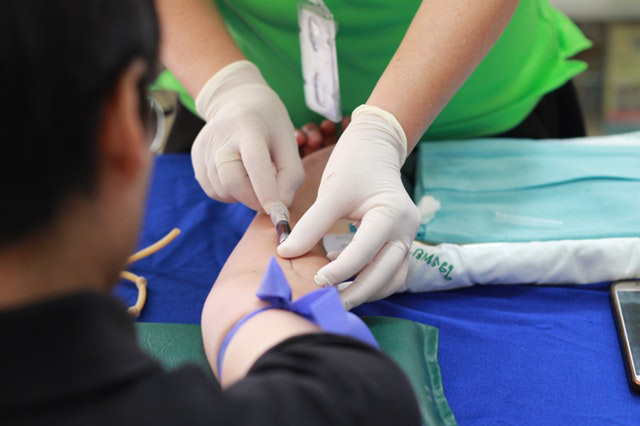Some Known Facts About Northeast Medical Institute - New Haven Campus Phlebotomy Course & Cna Class.
Some Known Facts About Northeast Medical Institute - New Haven Campus Phlebotomy Course & Cna Class.
Blog Article
Not known Factual Statements About Northeast Medical Institute - New Haven Campus Phlebotomy Course & Cna Class
Table of ContentsAn Unbiased View of Northeast Medical Institute - New Haven Campus Phlebotomy Course & Cna ClassThe Greatest Guide To Northeast Medical Institute - New Haven Campus Phlebotomy Course & Cna ClassUnknown Facts About Northeast Medical Institute - New Haven Campus Phlebotomy Course & Cna ClassThe 45-Second Trick For Northeast Medical Institute - New Haven Campus Phlebotomy Course & Cna ClassThe smart Trick of Northeast Medical Institute - New Haven Campus Phlebotomy Course & Cna Class That Nobody is DiscussingA Biased View of Northeast Medical Institute - New Haven Campus Phlebotomy Course & Cna Class
The usage of such devices need to be gone along with by other infection avoidance and control practices, and training in their usage.For setups with reduced resources, price is a motoring element in purchase of safety-engineered tools. Where safety-engineered tools are not readily available, competent usage of a needle and syringe is acceptable.
labelling); transportation problems; analysis of results for scientific management. In an outpatient department or clinic, offer a devoted phlebotomy cubicle containing: a tidy surface with two chairs (one for the phlebotomist and the other for the person); a hand wash basin with soap, running water and paper towels; alcohol hand rub. In the blood-sampling area for an outpatient division or clinic, supply a comfortable reclining sofa with an arm remainder.
Northeast Medical Institute - New Haven Campus Phlebotomy Course & Cna Class Things To Know Before You Buy
Make sure that the indicators for blood sampling are plainly specified, either in a written procedure or in documented directions (e.g. in a research laboratory kind). Accumulate all the tools needed for the treatment and location it within secure and easy reach on a tray or trolley, making certain that all the things are plainly visible.
Present yourself to the person, and ask the person to specify their complete name. Inspect that the lab type matches the person's identification (i.e. match the individual's information with the laboratory type, to make certain accurate identification).
Make the person comfortable in a supine placement (if possible). Place a clean paper or towel under the person's arm. Talk about the test to be done (see Annex F) and get spoken approval. The individual has a right to decline an examination at any kind of time prior to the blood tasting, so it is necessary to ensure that the individual has actually understood the procedure.
Northeast Medical Institute - New Haven Campus Phlebotomy Course & Cna Class Things To Know Before You Get This
Prolong the individual's arm and evaluate the antecubital fossa or forearm. Situate a blood vessel of a good size that is noticeable, straight and clear. The layout in Section 2.3, shows usual positions of the vessels, but many variations are feasible. The median cubital blood vessel exists between muscles and is generally the most simple to pierce.
DO NOT put the needle where blood vessels are drawing away, because this increases the chance of a haematoma. The capillary must show up without using the tourniquet. Finding the capillary will assist in figuring out the right size of needle. Use the tourniquet concerning 45 finger widths over the venepuncture website and re-examine the capillary.
Haemolysis, contamination and visibility of intravenous fluid and medication can all modify the results (39. Nursing staff and medical professionals may access main venous lines for samplings adhering to protocols. Nevertheless, specimens from central lines bring a risk of contamination or wrong lab test results (https://cherry-wombat-krt9cz.mystrikingly.com/blog/cna-courses-and-phlebotomy-training-at-northeast-medical-institute-new-haven). It is appropriate, but not excellent, to attract blood specimens when first introducing an in-dwelling venous gadget, before attaching the cannula to the intravenous fluids.
Not known Facts About Northeast Medical Institute - New Haven Campus Phlebotomy Course & Cna Class
Enable the location to completely dry. Failure to enable enough call time boosts the threat of contamination. DO NOT touch the cleaned site; particularly, DO NOT place a finger over the capillary to direct the shaft of the exposed needle. It the website is touched, repeat the disinfection. Execute venepuncture as complies with.
Ask the patient to create a clenched fist so the blood vessels are a lot more famous. Get in the vein swiftly at a 30 degree angle or less, and remain to introduce the needle along the blood vessel at the easiest angle of access - CNA Classes. When adequate blood has actually been collected, release the tourniquet BEFORE taking out the needle
Facts About Northeast Medical Institute - New Haven Campus Phlebotomy Course & Cna Class Uncovered
Take out the needle delicately and use mild pressure to the website with a clean gauze or completely dry cotton-wool sphere. Ask the client to hold the gauze or cotton wool in position, with the arm expanded and increased. Ask the client NOT to flex the arm, due to the fact that doing so creates a haematoma.

The Ultimate Guide To Northeast Medical Institute - New Haven Campus Phlebotomy Course & Cna Class
Do not press the syringe plunger because extra stress boosts the risk of haemolysis. Where feasible, maintain televisions in a rack and relocate the shelf in the direction of you. Infuse downwards right into the proper coloured stopper. DO NOT remove the stopper since it will certainly release the vacuum cleaner. If the example tube does not have official site a rubber stopper, inject incredibly gradually right into the tube as decreasing the pressure and velocity utilized to transfer the specimen decreases the risk of haemolysis.

Report this page